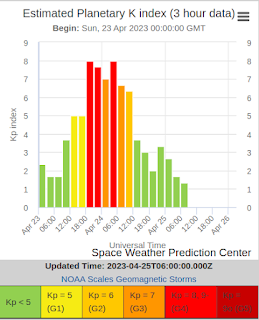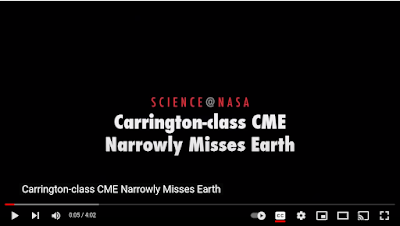
#17,424
Although it may sound like the plot from any of a hundred cheesy-made-for-cable Sci Fi movies - or the hyperbolic content from thousands of `clickbaity' YouTube videos - space weather poses genuine risks for us here on earth (and in space), and has has been a serious concern for FEMA for decades.
Like great earthquakes (8.0+), and severe pandemics, truly destructive solar flares and CMEs are extremely rare – but they do occur.
It is a topic that we've revisited a number of times over the years (see below), primarily due to the impacts they could have on our modern electrical infrastructure (see NIAC: Surviving A Catastrophic Power Outage).
USGS: Preparing The Nation For Severe Space Weather
Executive Order: Coordinating Efforts to Prepare the Nation for Space Weather Events
The UK’s Space Weather Preparedness Strategy
NASA: The Solar Super Storm Of 2012
Two days ago the earth was hit by a G4 solar storm due to a (relatively minor) earth-directed filament eruption on the sun. It sparked auroras as far south as the southern United States, but had only limited impacts on the electrical grid.
The summary from Spaceweather.gov follows:
Starting at 1:37 PM EDT on Sunday, April 23, 2023, Earth was impacted by a Severe Geomagnetic Storm (a level 4 of 5 on NOAA’s space weather G- scale). The most likely areas of impact extend across the northern tier of the United States (north of 45 degrees latitude) and into Canada. These impacts generally include widespread, yet manageable, irregularities to the power grid, spacecraft, global positioning systems, and radio communications. Additionally, if this storm persists into the evening, the Aurora Borealis may be seen as far south as Alabama and northern California. Currently, the Severe Geomagnetic Storm is expected to persist until 2:00 AM EDT on April 24, 2023.
On the afternoon of April 23, 2023, at 2:12 PM EDT, a Moderate Solar Flare (M1.7) erupted from the sun expelling a billion tons of superheated magnetized gas from the sun known as plasma. This ejection, known as a Coronal Mass Ejection (CME), traveled at nearly two million miles per hour and reached Earth in two days. NOAA’s Space Weather Prediction Center had issued a Minor Geomagnetic Storm (G1) watch for April 23, 2023, and a Moderate Geomagnetic Storm (G2) watch for April 24, 2023, with only a 5% and 30% chance of the storm reaching strong-extreme conditions on the two days. A Strong-Extreme Geomagnetic Storm Warning was issued by SWPC at 3:26 PM EDT on April 23, 2023. The Geomagnetic Storm arrived earlier and was stronger than expected.
Compared to the great solar storm of 1859 (the Carrington Event), the solar storm of 1989 which brought down Quebec's power grid, and the geomagnetic storm of 2003 which disrupted power in northern Europe and damaged several satellites, this was a fairly minor event.
- The Sydkraft utility group in Sweden reported that strong geomagnetically induced currents (GIC) over Northern Europe caused transformer problems and even a system failure and subsequent blackout.
- Radiation storm levels were high enough to prompt NASA officials to issue a flight directive to the ISS astronauts to take precautionary shelter. Airlines took unprecedented actions in their high latitude routes to avoid the high radiation levels and communication blackout areas. Rerouted flights cost airlines $10,000 to $100,000 per flight.
- Numerous anomalies were reported by deep space missions and by satellites at all orbits. GSFC Space Science Mission Operations Team indicated that approximately 59% of the Earth and Space science missions were impacted. The storms are suspected to have caused the loss of the $640 million ADEOS-2 spacecraft. On board the ADEOS-2 was the $150 million NASA SeaWinds instrument.
- Due to the variety and intensity of this solar activity outbreak, most industries vulnerable to space weather experienced some degree of impact to their operations.
Had this been an earth directed storm the size of the 1859 event, we might still be picking up the pieces. While it has been nearly 20 years since out last major storm, as we learned in 2014 (see NASA: The Solar Super Storm Of 2012), we narrowly escaped being hit again in 2012.
Our sun goes through a roughly 11-year cycle, over which time solar activity (sunspots, flares, Coronal Mass Ejections (CMEs), etc.) build to a maximum, and its magnetic field reverses, and then tapers off to a low activity minimum.
The following NOAA graphic shows the suns progress over solar cycle 24 between 2010 and 2020.
The sun hit its last solar maximum peak in 2014, and had been growing quieter with each passing year. That is, until a couple of yeas ago, when we started seeing increased signs of solar activity which is expected to peak in 2025.
Between our growing dependence on highly vulnerable satellites and electrical grids - and reports that our planet's magnetic field continues to weaken (see ESA Swarm probes weakening of Earth’s magnetic field) - there are concerns that we are becoming increasingly vulnerable to the effects of a major solar storm.
FEMA RELEASES SPACE WEATHER TRAININGpublished: Monday, April 24, 2023 17:24 UTC
FEMA has developed a training module that introduces both space weather and space weather impacts. It also provides excellent background on the US Government's plan for an extreme space weather storm. This course covers the lessons necessary for a greater understanding of space weather and its impacts, strengthens understanding of space weather events; the potential impacts from those events; and the roles of the Federal Government as well as the local and jurisdictional Emergency Manager in preparing for and mitigating such impacts. It can be found at the FEMA Website(link is external).
Either way, I highly recommend the course to anyone interested in learning about the risks posed by extreme space weather, and how our nation is preparing for it.



